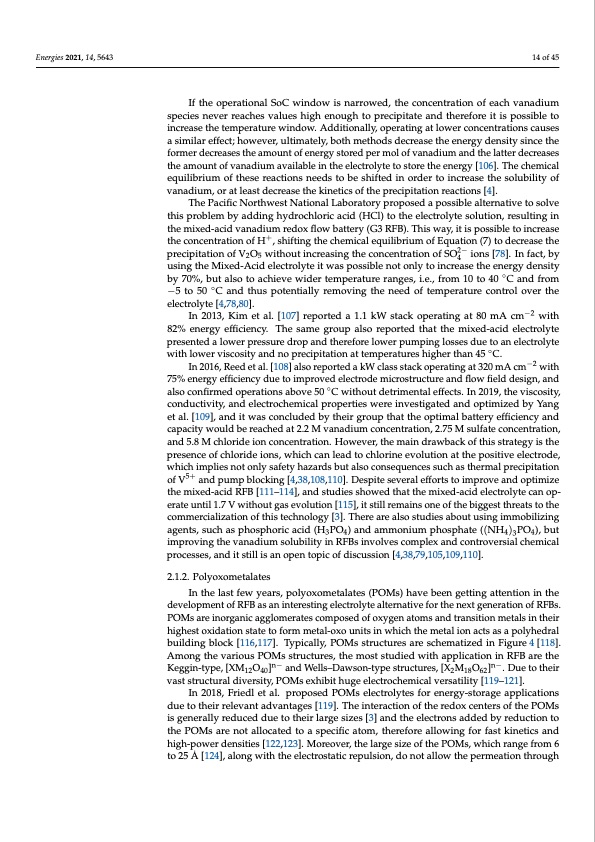
PDF Publication Title:
Text from PDF Page: 014
Energies 2021, 14, 5643 14 of 45 If the operational SoC window is narrowed, the concentration of each vanadium species never reaches values high enough to precipitate and therefore it is possible to increase the temperature window. Additionally, operating at lower concentrations causes a similar effect; however, ultimately, both methods decrease the energy density since the former decreases the amount of energy stored per mol of vanadium and the latter decreases the amount of vanadium available in the electrolyte to store the energy [106]. The chemical equilibrium of these reactions needs to be shifted in order to increase the solubility of vanadium, or at least decrease the kinetics of the precipitation reactions [4]. The Pacific Northwest National Laboratory proposed a possible alternative to solve this problem by adding hydrochloric acid (HCl) to the electrolyte solution, resulting in the mixed-acid vanadium redox flow battery (G3 RFB). This way, it is possible to increase the concentration of H+, shifting the chemical equilibrium of Equation (7) to decrease the precipitation of V2O5 without increasing the concentration of SO2− ions [78]. In fact, by 4 using the Mixed-Acid electrolyte it was possible not only to increase the energy density by 70%, but also to achieve wider temperature ranges, i.e., from 10 to 40 ◦C and from −5 to 50 ◦C and thus potentially removing the need of temperature control over the electrolyte [4,78,80]. In 2013, Kim et al. [107] reported a 1.1 kW stack operating at 80 mA cm−2 with 82% energy efficiency. The same group also reported that the mixed-acid electrolyte presented a lower pressure drop and therefore lower pumping losses due to an electrolyte with lower viscosity and no precipitation at temperatures higher than 45 ◦C. In 2016, Reed et al. [108] also reported a kW class stack operating at 320 mA cm−2 with 75% energy efficiency due to improved electrode microstructure and flow field design, and also confirmed operations above 50 ◦C without detrimental effects. In 2019, the viscosity, conductivity, and electrochemical properties were investigated and optimized by Yang et al. [109], and it was concluded by their group that the optimal battery efficiency and capacity would be reached at 2.2 M vanadium concentration, 2.75 M sulfate concentration, and 5.8 M chloride ion concentration. However, the main drawback of this strategy is the presence of chloride ions, which can lead to chlorine evolution at the positive electrode, which implies not only safety hazards but also consequences such as thermal precipitation of V5+ and pump blocking [4,38,108,110]. Despite several efforts to improve and optimize the mixed-acid RFB [111–114], and studies showed that the mixed-acid electrolyte can op- erate until 1.7 V without gas evolution [115], it still remains one of the biggest threats to the commercialization of this technology [3]. There are also studies about using immobilizing agents, such as phosphoric acid (H3PO4) and ammonium phosphate ((NH4)3PO4), but improving the vanadium solubility in RFBs involves complex and controversial chemical processes, and it still is an open topic of discussion [4,38,79,105,109,110]. 2.1.2. Polyoxometalates In the last few years, polyoxometalates (POMs) have been getting attention in the development of RFB as an interesting electrolyte alternative for the next generation of RFBs. POMs are inorganic agglomerates composed of oxygen atoms and transition metals in their highest oxidation state to form metal-oxo units in which the metal ion acts as a polyhedral building block [116,117]. Typically, POMs structures are schematized in Figure 4 [118]. Among the various POMs structures, the most studied with application in RFB are the Keggin-type, [XM12O40]n− and Wells–Dawson-type structures, [X2M18O62]n−. Due to their vast structural diversity, POMs exhibit huge electrochemical versatility [119–121]. In 2018, Friedl et al. proposed POMs electrolytes for energy-storage applications due to their relevant advantages [119]. The interaction of the redox centers of the POMs is generally reduced due to their large sizes [3] and the electrons added by reduction to the POMs are not allocated to a specific atom, therefore allowing for fast kinetics and high-power densities [122,123]. Moreover, the large size of the POMs, which range from 6 to 25 A ̇ [124], along with the electrostatic repulsion, do not allow the permeation throughPDF Image | PNNL Vanadium Redox Flow Battery Stack

PDF Search Title:
PNNL Vanadium Redox Flow Battery StackOriginal File Name Searched:
energies-14-05643-v2.pdfDIY PDF Search: Google It | Yahoo | Bing
Salgenx Redox Flow Battery Technology: Salt water flow battery technology with low cost and great energy density that can be used for power storage and thermal storage. Let us de-risk your production using our license. Our aqueous flow battery is less cost than Tesla Megapack and available faster. Redox flow battery. No membrane needed like with Vanadium, or Bromine. Salgenx flow battery
| CONTACT TEL: 608-238-6001 Email: greg@salgenx.com | RSS | AMP |